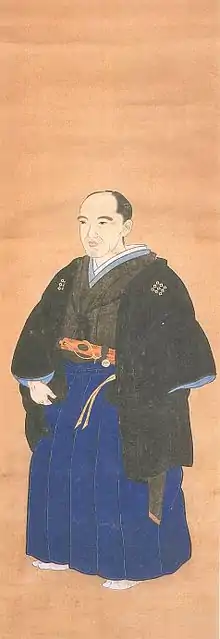Matsudaira Munehide | |
|---|---|
 A portrait of Matsudaira (Honjo) Munehide. | |
| Lord of Miyazu | |
| In office 1841–1866 | |
| Preceded by | Matsudaira Muneakira |
| Succeeded by | Matsudaira Munetake |
| Personal details | |
| Born | October 21, 1809 |
| Died | December 20, 1873 (aged 64) |
| Nationality | Japanese |
Matsudaira Munehide (松平 宗秀, October 21, 1809 – December 20, 1873), also known as Honjō Munehide (本庄 宗秀), was a Japanese daimyō of the late Edo period who ruled the Miyazu Domain (modern-day Miyazu, Kyoto). He was known by the titles "Hōki-no-kami" (伯耆守, Hōki-no-kami) (post-1840) or "Tango-no-kami" (丹後守, Tango-no-kami) (post-1868).[1]
Official in the bakufu
Munehide served in a variety of positions in the Tokugawa shogunate, ultimately rising to the position of rōjū in the period from September 1864 through September 1866.[1] Previously, he had been Kyoto shoshidai in the period spanning July 26, 1862, through September 17, 1862.[2] In addition, he served as jisha-bugyō from November 1858 through November 1861; and he was Osaka jōdai from February 1861 through July 1862.[1]
Restoration official
In the Meiji era, he served as chief priest of the Ise Shrine.
Notes
- 1 2 3 Beasley, William. (1955). Select Documents on Japanese Foreign Policy, 1853–1868, p. 332.
- ↑ Meyer, Eva-Maria. "Gouverneure von Kyôto in der Edo-Zeit". Archived 2008-04-11 at the Wayback Machine University of Tüebingen (in German).
References
- Beasley, William G. (1955). Documents on Japanese Foreign Policy, 1853-1868. London: Oxford University Press. [reprinted by RoutledgeCurzon, London, 2001. ISBN 978-0-19-713508-2 (cloth)]